Abstract
Earlier animal experiments have shown that selenium depletion may decrease immune functions. In this human study, 40 volunteers from a population with low serum selenium concentrations were supplemented with selenium or placebo for 11 weeks. Blood samples were drawn at intervals for analysis of selenium status and immune function. At the end of the supplementation period, plasma selenium levels were 74 ng/ml in the placebo group and 169 ng/ml in the supplemented group. The improvement in selenium status was associated with a 57% increase in the activity of platelet glutathione peroxidase in the group supplemented with selenium, but there was no increase in the activity of this enzyme in the placebo-treated subjects. Immune function was measured in vitro by tests of lymphocyte and granulocyte activity. Intracellular killing of Staphylococcus aureus by granulocytes was slightly lower in the placebo group than in the selenium group at the end of the supplementation period (77.2 compared to 85.2%; P less than 0.05). No significant changes were observed in phagocytosis, chemotactic factor generation, antibody or leukocyte migration inhibitory factor production by lymphocytes, or proliferative responses to phytohemagglutinin or concanavalin A. These results suggest that the selenium deficiency of the order found in Finland and some other areas of the world has little, if any, influence on the immune functions measured in this study.
Full text
PDF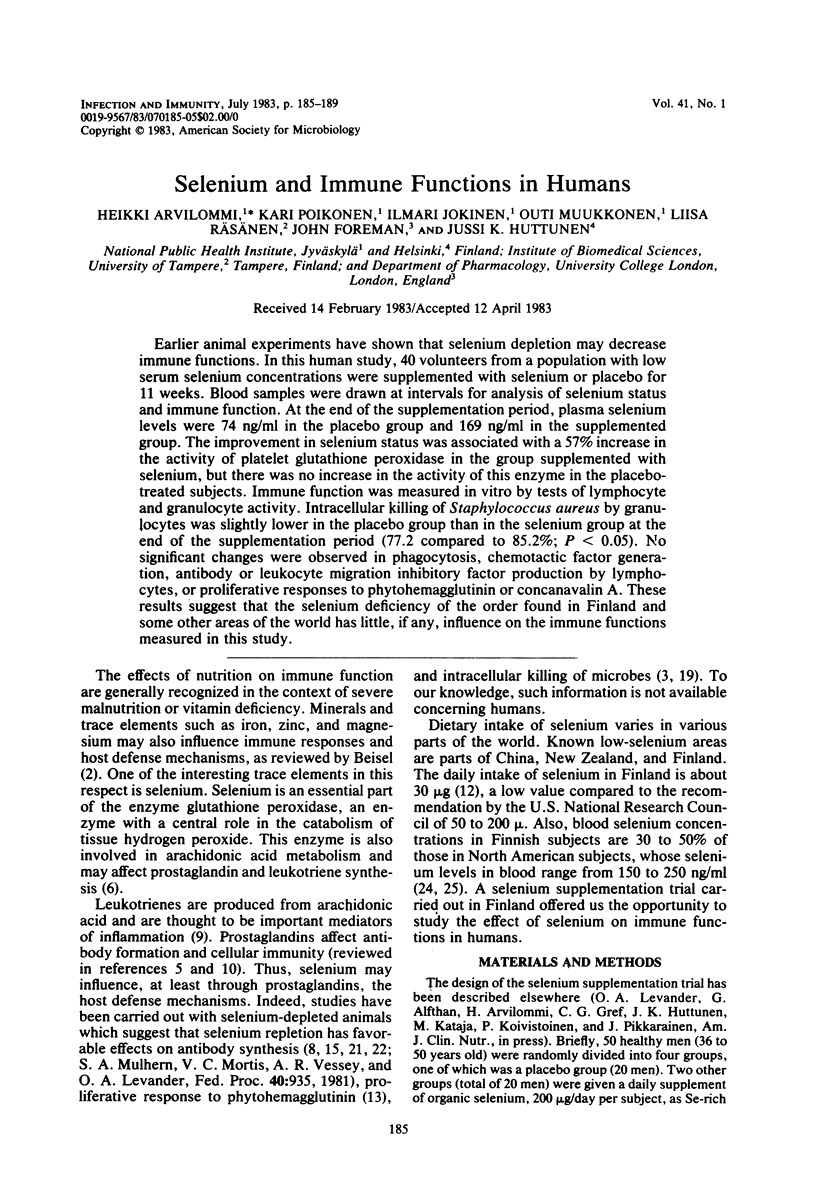
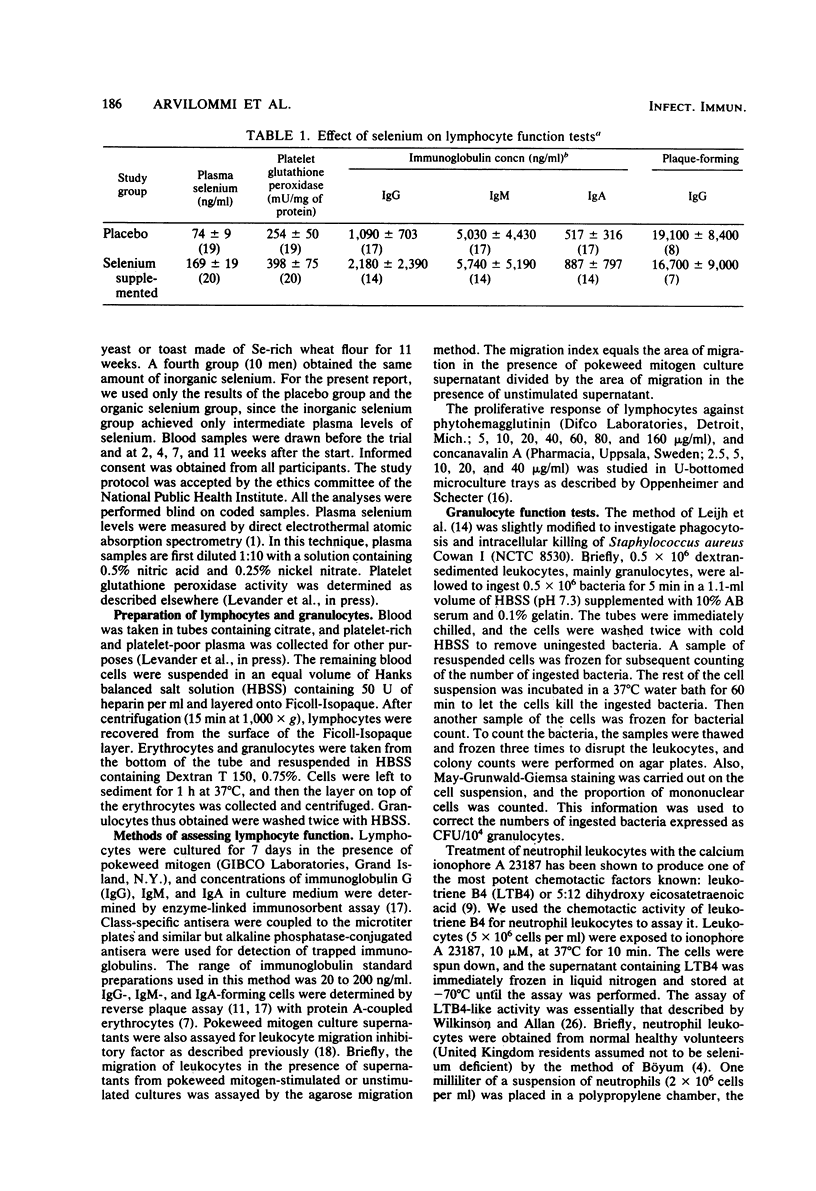
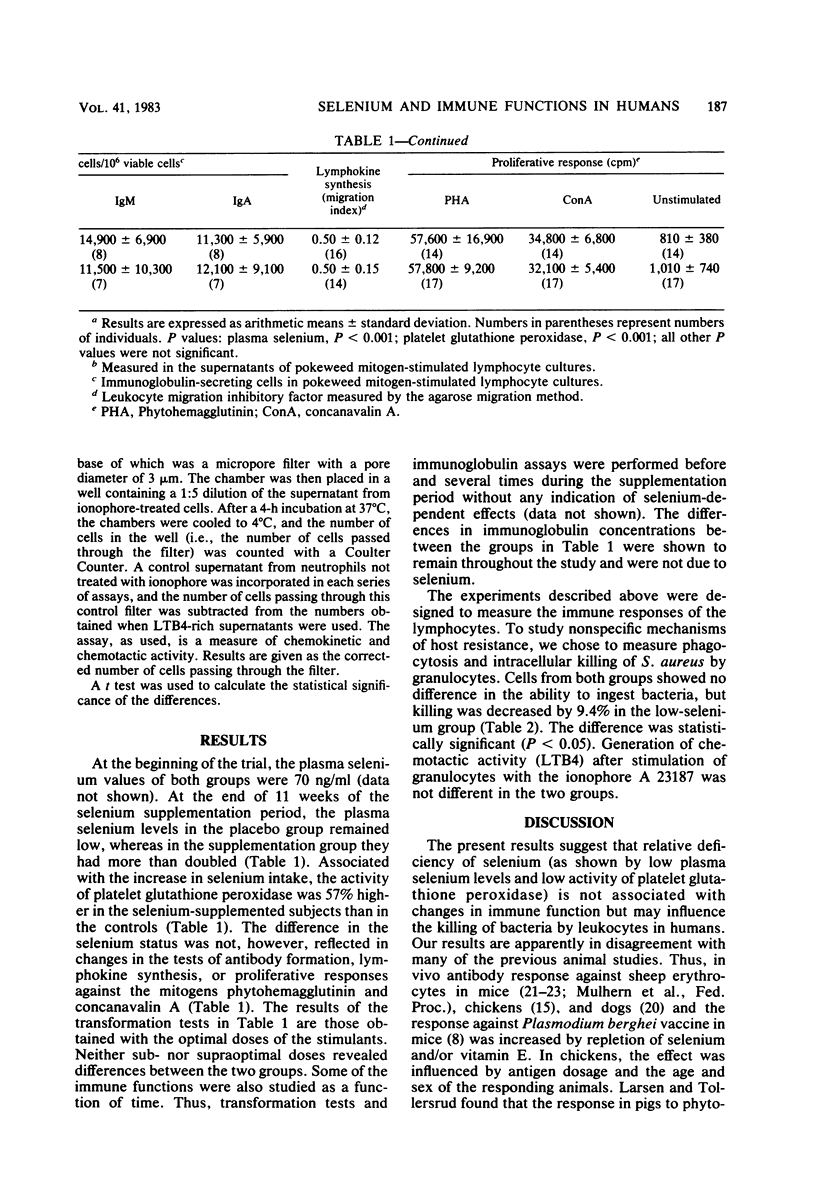
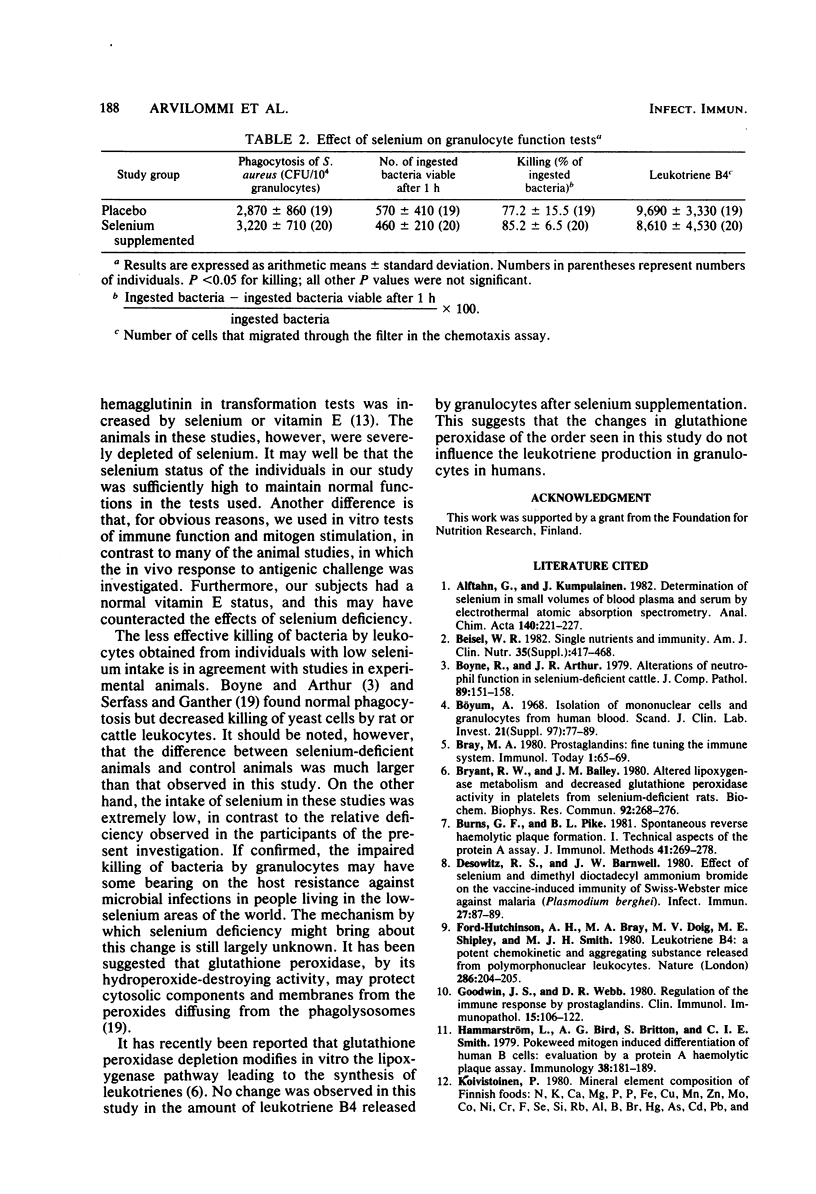
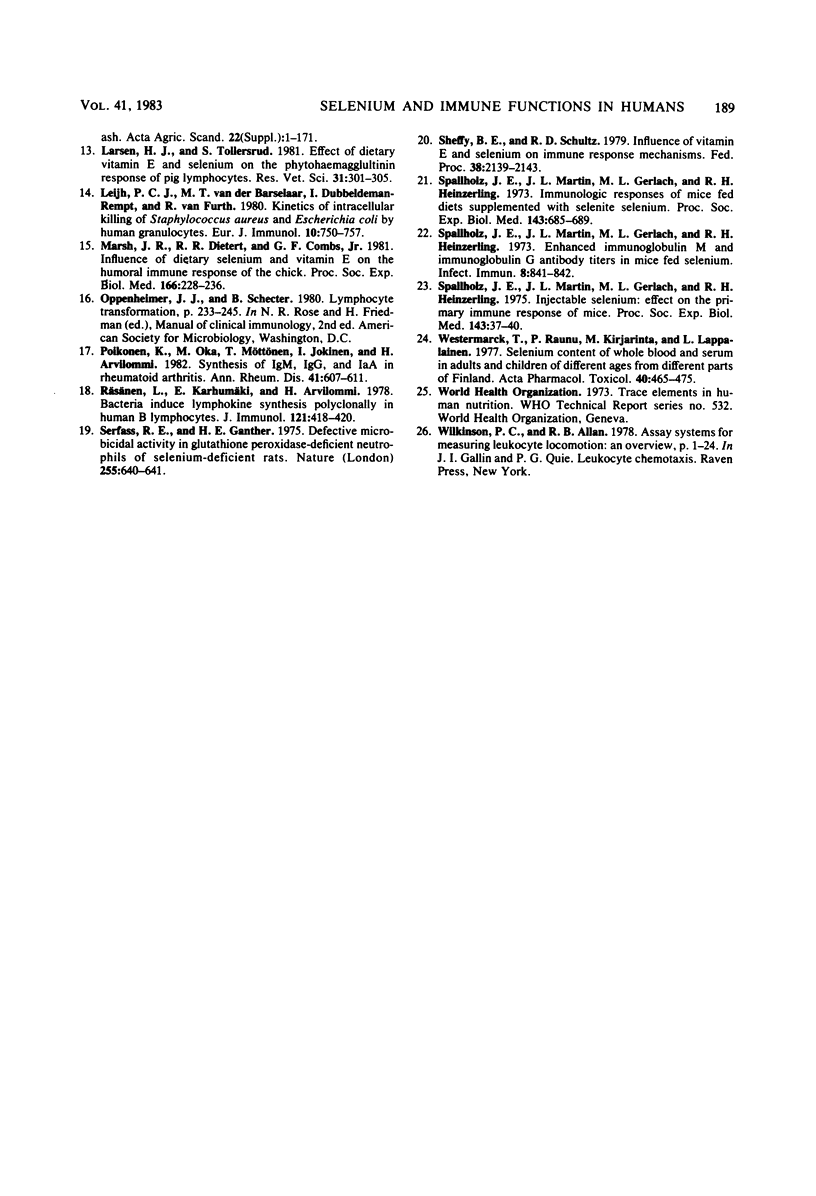
Selected References
These references are in PubMed. This may not be the complete list of references from this article.
- Beisel W. R. Single nutrients and immunity. Am J Clin Nutr. 1982 Feb;35(2 Suppl):417–468. doi: 10.1093/ajcn/35.2.417. [DOI] [PubMed] [Google Scholar]
- Boyne R., Arthur J. R. Alterations of neutrophil function in selenium-deficient cattle. J Comp Pathol. 1979 Jan;89(1):151–158. doi: 10.1016/0021-9975(79)90018-5. [DOI] [PubMed] [Google Scholar]
- Bryant R. W., Bailey J. M. Altered lipoxygenase metabolism and decreased glutathione peroxidase activity in platelets from selenium-deficient rats. Biochem Biophys Res Commun. 1980 Jan 15;92(1):268–276. doi: 10.1016/0006-291x(80)91548-x. [DOI] [PubMed] [Google Scholar]
- Burns G. F., Pike B. L. Spontaneous reverse haemolytic plaque formation. I. Technical aspects of the protein A assay. J Immunol Methods. 1981;41(3):269–277. doi: 10.1016/0022-1759(81)90190-3. [DOI] [PubMed] [Google Scholar]
- Böyum A. Isolation of mononuclear cells and granulocytes from human blood. Isolation of monuclear cells by one centrifugation, and of granulocytes by combining centrifugation and sedimentation at 1 g. Scand J Clin Lab Invest Suppl. 1968;97:77–89. [PubMed] [Google Scholar]
- Desowitz R. S., Barnwell J. W. Effect of selenium and dimethyl dioctadecyl ammonium bromide on the vaccine-induced immunity of Swiss-Webster mice against malaria (Plasmodium berghei). Infect Immun. 1980 Jan;27(1):87–89. doi: 10.1128/iai.27.1.87-89.1980. [DOI] [PMC free article] [PubMed] [Google Scholar]
- Goodwin J. S., Webb D. R. Regulation of the immune response by prostaglandins. Clin Immunol Immunopathol. 1980 Jan;15(1):106–122. doi: 10.1016/0090-1229(80)90024-0. [DOI] [PubMed] [Google Scholar]
- Hammarström L., Bird A. G., Britton S., Smith C. I. Pokeweed mitogen induced differentiation of human B cells: evaluation by a protein A haemolytic plaque assay. Immunology. 1979 Sep;38(1):181–189. [PMC free article] [PubMed] [Google Scholar]
- Larsen H. J., Tollersrud S. Effect of dietary vitamin E and selenium on the phytohaemagglutinin response of pig lymphocytes. Res Vet Sci. 1981 Nov;31(3):301–305. [PubMed] [Google Scholar]
- Leijh P. C., van den Barselaar M. T., Dubbeldeman-Rempt I., van Furth R. Kinetics of intracellular killing of Staphylococcus aureus and Escherichia coli by human granulocytes. Eur J Immunol. 1980 Oct;10(10):750–757. doi: 10.1002/eji.1830101005. [DOI] [PubMed] [Google Scholar]
- Marsh J. A., Dietert R. R., Combs G. F., Jr Influence of dietary selenium and vitamin E on the humoral immune response of the chick. Proc Soc Exp Biol Med. 1981 Feb;166(2):228–236. doi: 10.3181/00379727-166-41051. [DOI] [PubMed] [Google Scholar]
- Poikonen K., Oka M., Möttönen T., Jokinen I., Arvilommi H. Synthesis of IgM, IgG and IgA in rheumatoid arthritis. Ann Rheum Dis. 1982 Dec;41(6):607–611. doi: 10.1136/ard.41.6.607. [DOI] [PMC free article] [PubMed] [Google Scholar]
- Räsänen L., Karhumäki E., Arvilommi H. Bacteria induce lymphokine synthesis polyclonally in human B lymphocytes. J Immunol. 1978 Aug;121(2):418–420. [PubMed] [Google Scholar]
- Serfass R. E., Ganther H. E. Defective microbicidal activity in glutathione peroxidase-deficient neutrophils of selenium-deficient rats. Nature. 1975 Jun 19;255(5510):640–641. doi: 10.1038/255640a0. [DOI] [PubMed] [Google Scholar]
- Sheffy B. E., Schultz R. D. Influence of vitamin E and selenium on immune response mechanisms. Fed Proc. 1979 Jun;38(7):2139–2143. [PubMed] [Google Scholar]
- Spallholz J. E., Martin J. L., Gerlach M. L., Heinzerling R. H. Enhanced immunoglobulin M and immunoglobulin G antibody titers in mice fed selenium. Infect Immun. 1973 Nov;8(5):841–842. doi: 10.1128/iai.8.5.841-842.1973. [DOI] [PMC free article] [PubMed] [Google Scholar]
- Spallholz J. E., Martin J. L., Gerlach M. L., Heinzerling R. H. Immunologic responses of mice fed diets supplemented with selenite selenium. Proc Soc Exp Biol Med. 1973 Jul;143(3):685–689. doi: 10.3181/00379727-143-37391. [DOI] [PubMed] [Google Scholar]
- Spallholz J. E., Martin J. L., Gerlach M. L., Heinzerling R. H. Injectable selenium: effect on the primary response of mice (38472). Proc Soc Exp Biol Med. 1975 Jan;148(1):37–40. doi: 10.3181/00379727-148-38472. [DOI] [PubMed] [Google Scholar]
- Westermarck T., Raunu P., Kirjarinta M., Lappalainen L. Selenium content of whole blood and serum in adults and children of different ages from different parts of Finland. Acta Pharmacol Toxicol (Copenh) 1977 Apr;40(4):465–475. [PubMed] [Google Scholar]


